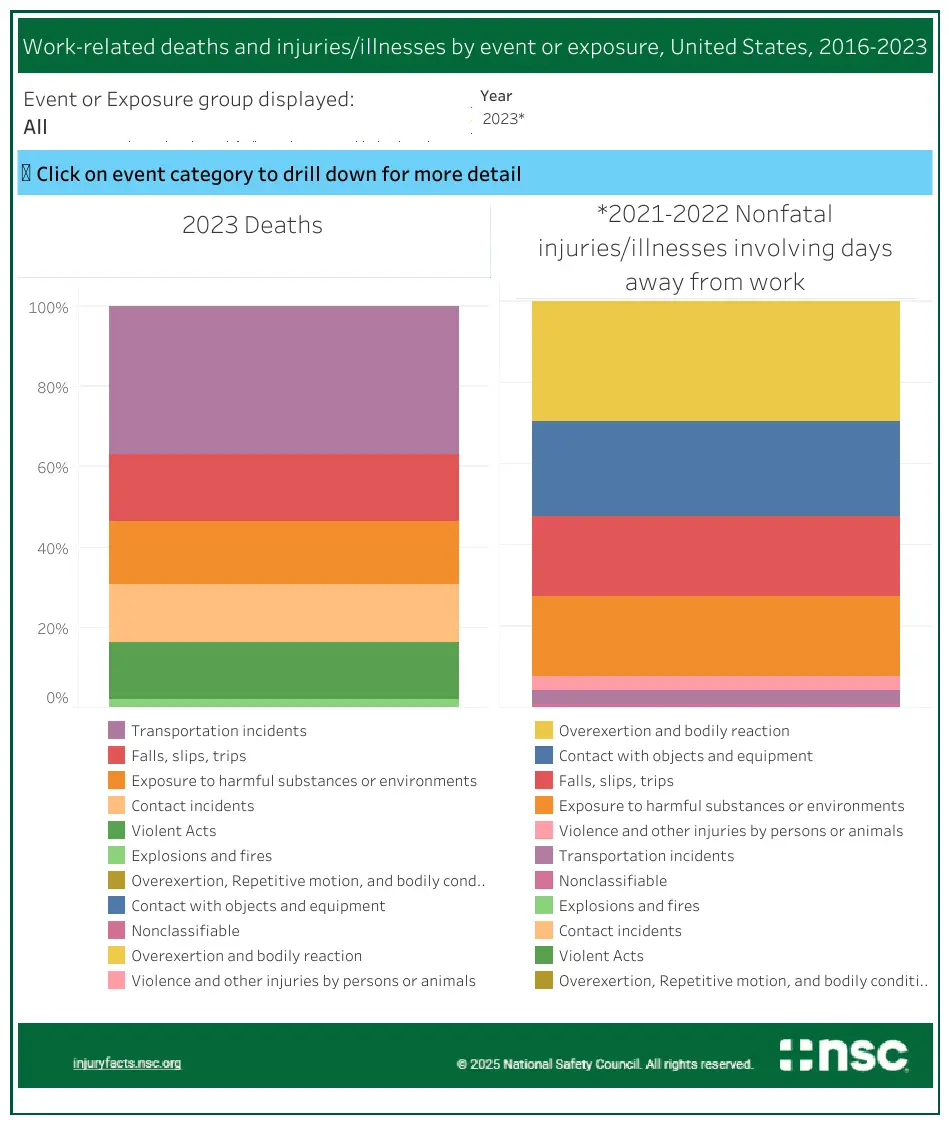In 2023, there were 5,283 fatal work injuries recorded in the United States, meaning a worker died every 99 minutes from a work-related injury.
And while fatality rates may be among the most concerning statistics, they’re far from the only ones. In fact, every type of workplace safety metric gives us valuable insight into improving safety in the workplace—and the Days Away, Restricted, or Transferred rate is no exception.
So, what should companies know about the DART rate?
This comprehensive guide on DART discusses the significance of this metric, how to calculate the DART rate, and practical steps to improve workplace safety.
What is the DART Rate?
The DART rate, or Days Away, Restricted, or Transferred rate, is a safety metric that measures the number of workplace injuries and illnesses that result in days away from work, restricted work activities, or job transfers per 100 full-time employees. As we’ll see below, this metric serves as a key indicator of workplace safety performance.
Importance of the DART Rate in Workplace Safety
DART rates act as a critical measurement for workplace safety programs. Why?
Because companies can use this metric to:
- Identify trends in workplace injuries: By evaluating the common workplace injuries that contribute to a company’s DART rate, such as slips and falls, vehicle-related accidents, or even workplace violence, companies can proactively address hazards and improve workplace safety.
- Evaluate the effectiveness of safety protocols: If your company has a high DART rate, then it’s a clear indicator that there are safety issues in the workplace. In addition to helping you identify hazards, your DART safety metric may provide valuable insight into post-injury care. For instance, if minor injuries result in a high number of days off, then you may want to evaluate your workplace injury management approach, as proper injury support can help minimize the severity of injuries.
- Ensure they meet OSHA standards: Since DART metrics help identify potential safety risks, companies can implement targeted safety improvements to reduce workplace injuries and lower their risk of OSHA violations. A lower DART rate typically means fewer OSHA inspections, therefore reducing the risk of fines.
Overall, lower DART rates typically indicate safer working conditions. As a result, companies can reduce liability risks, improve employee retention, increase productivity, and positively impact insurance costs.
How to Calculate the DART Rate?

Below we’ve provided the official formula for calculating DART rate:
DART Rate = Number of DART Incidents × 200,000 / Total Hours Worked by All Employees
Here’s what each component represents:
- Number of DART incidents: This is the total number of OSHA-recordable workplace injuries or illnesses resulting in days away from work, restricted work, or transfers.
- 200,000: This number represents 100 employees working 40 hours a week for a 50-week calendar year, serving as the standard base for calculating incidence rates.
- Total hours worked: This is the cumulative number of hours worked by all employees during the reporting period.
Let’s take a look at an example. Let’s say a construction company reported 4 workplace injuries that resulted in days away from work. If their employees worked a total of 450,000 hours that reporting period, then their DART calculation would look like this:
DART Rate = 4 × 200,000 / 450,000
DART Rate = 1.77
They can then compare this number to the industry average to better understand their safety performance and identify areas for improvement.
Understanding OSHA Recordable Incidents
OSHA established general recording criteria to help companies determine what qualifies as a recordable incident. According to these criteria, an injury or illness must be recorded if it results in the following:
- Death
- Days away from work
- Restricted work or transfer to another job
- Medical treatment beyond first aid
- Loss of consciousness
- A significant injury or illness diagnosed by a physician or other licensed healthcare professional
However, when calculating DART rate, only cases resulting in days away from work, restricted work, or job transfers are included.
A common misconception is that any OSHA recordable incident impacts the DART rate, but that’s not the case. Let’s say a worker gets a deep cut that requires stitches. Since this treatment goes beyond first aid, it would be considered a recordable incident. That said, if the worker does not take any days off or does not require restricted work or job transfers, then it would not be counted toward DART.
Understanding this distinction helps businesses track safety metrics accurately.
What is a Good DART Rate?

A “good” DART rate is typically considered one that falls below the industry average. Since every industry is distinct—with unique internal processes and hazards—every company must compare their DART rate with industry-specific benchmarks to assess their safety performance.
You can do this by reviewing this chart provided by the U.S. Bureau of Labor Statistics.
According to this data, the average DART rate for private industries in 2023 was 1.5 cases per 100 full-time workers. The manufacturing industry, on the other hand, had an average of 1.8 cases.
The construction industry also reported 1.5 cases per 100 full-time workers. We can now compare this figure to the example we did above.
The hypothetical construction company that reported 4 workplace injuries had a DART rate of 1.77. Since the industry average is 1.5, this means that they have a higher-than-average DART rate, suggesting they may have unsafe working conditions that require attention.
Strategies to Reduce the DART Rate
Now that we know what the DART safety metric is and how to calculate it, the next big question is: How can you reduce your company’s DART rate?
Keep reading for valuable strategies that businesses of all sizes can implement.
Strengthening Safety Training Programs
Comprehensive training programs are key to increasing safety awareness, as they help workers understand the risks associated with their everyday tasks. As a result, companies can lower operational disruptions caused by injuries and promote a strong safety culture in the workplace.
This training—which may involve hands-on drills, refresher courses, and digital learning tools—should cover first aid in the workplace, hazard reporting and response procedures, proper equipment handling, and more. It’s important to note that interactive, job-specific training is more effective than general safety training, as it addresses the unique hazards and daily functions associated with a particular role.
Enhancing Safety Audits and Hazard Checks
Regular safety audits and hazard assessments allow businesses to identify risks before they lead to injuries. In addition to scheduled audits, companies can perform surprise checks to ensure everything is running smoothly outside of routine inspections. Company leaders can also use data-driven risk analysis to identify and assess potential risks.
During this process, we recommend gathering employee feedback, as workers can offer valuable insights into everyday tasks, faulty equipment, and potential safety hazards.
Furthermore, JobSiteCare’s workplace safety solutions enable companies to gain expert insights and mitigate risks proactively, helping streamline safety audits and maintain compliance.
Encouraging Proactive Injury Reporting
Companies should encourage workers to report hazards, near misses, and minor injuries before they become serious. To accomplish this, company leaders can create a non-punitive, transparent reporting system that offers anonymous reporting and removes fear of retaliation; supervisors must also be trained to respond appropriately to reports of potential hazards.
With JobSiteCare’s injury management services, you can ensure early intervention and prevent unnecessary OSHA recordables, reducing your total recordable incident rate and lost time injuries.
Improving Injury Response and Case Management
Companies should have a detailed workplace injury response procedure in place to reduce the severity of injuries, improve OSHA metrics, and minimize disruptions. Part of this process is creating a return to work program that keeps employees engaged through modified duties, reducing the need for extended absences.
To enhance workplace injury response, companies can incorporate telemedicine into workplace safety management, ensuring injured workers receive immediate medical attention. With JobSiteCare’s occupational health telemedicine solutions, you can connect with our physicians in 60 seconds or less for a prompt injury assessment and immediate, appropriate care.
Optimizing Workspaces for Safety
A key aspect of workplace injury prevention is fostering a workplace that prioritizes safety and employee health. Businesses can reduce the risk of injuries in various ways, such as designing ergonomic workstations, providing proper lifting equipment and anti-fatigue mats, and implementing automation. With strategic workplace modifications, your company can prevent musculoskeletal disorders and repetitive strain injuries.
Using Data to Improve Workplace Safety
Tracking and analyzing DART rate trends helps businesses refine their safety protocols, training programs, and risk management strategies. There are various tools that businesses can adopt to help them prevent injuries, such as predictive analytics, safety dashboards, and real-time reporting tools.
At JobSiteCare, we combine medical expertise with data-driven insights to help companies proactively manage workplace risks and reduce the costs of workplace injuries.
Conclusion
Having a low DART rate demonstrates your company’s commitment to workplace safety. By implementing strategies like proactive training, regular audits, quick injury response, and ergonomic improvements, your company can create a safer and more productive work environment.
With JobSiteCare’s expertise in workplace injury care, you can receive reliable, on-site medical services that support a healthier and happier work environment.
Whether you’re interested in reducing your company’s DART rate, minimizing employee health insurance costs, or improving your return-to-work program, our injury management solutions will help you achieve your goals.
Contact us today to learn more about our services.
FAQs About Dart Rates
1. What are the most common workplace injuries that contribute to a high DART rate?
The injuries with the most DART cases include overexertion and bodily reaction, contact with objects and equipment, slips, trips, and falls, and exposure to harmful substances or environments.
2. Why is early injury reporting crucial for reducing lost workdays?
Early injury response and reporting enable quick medical attention, prevent minor injuries from escalating, and ensure timely workplace adjustments to support recovery.
3. How can businesses reduce their DART rate effectively?
Businesses can reduce their DART rate by strengthening safety training programs, improving safety audits, encouraging proactive injury reporting, enhancing injury response, optimizing workspaces for safety, and tracking and analyzing DART trends to refine safety protocols.
4. Can telemedicine services help reduce the DART rate, and how?
Yes, telemedicine services help reduce a company’s DART rate by offering immediate medical assessments, facilitating early treatment, providing end-to-end care management, and enabling quicker return-to-work solutions.
5. What is a Return-to-Work (RTW) program, and how does it impact the DART rate?
A RTW program is designed to facilitate an injured or ill employee’s safe and efficient return to the workplace.These programs help lower a company’s DART rate by enabling injured employees to resume modified duties sooner, thereby helping companies reduce lost workdays and minimize restricted or transferred cases.
6. How does safety training help lower the DART rate?
Safety training helps workers understand the risks associated with their everyday tasks, thereby lowering operational disruptions from injuries and promoting a strong safety culture in the workplace.


